Prior to this month, I’d only been to Michigan once – a 24-hour, deadline-driven in-and-out with a 1988 presidential candidate who was better at delivering speeches than harnessing votes. In my narrow mind’s eye, “Michigan” meant little more than struggling car companies, heavy-handed unions, a bankrupt, crime-ridden Detroit and the contaminated-water public health crisis of Flint.
Talk about unfair and out of date.
We just spent a wonderful two weeks in Michigan – from Dearborn to Bay City, Alpena, Mackinaw and Petoskey all the way up to Sault Ste. Marie, Whitefish Point, Grand Marais, Munising, Marquette and Copper Harbor in the Upper Peninsula. Dense forests, cascading waterfalls, dramatic cliff “paintings,” intriguing islands and inlets – Michigan has it all.
We’ve loved many places so far on our Year on the Edges of America adventure. The Shenandoah Mountains of Virginia… the Hudson River Valley in New York… Maine’s North Atlantic shoreline…. Quebec was gorgeous and dramatic, too – the Chemin du Roy along the St. Lawrence River and the Chemin des Patriotes along the Rivière Richelieu are among our all-time favorite drives.
But Michigan in the summertime – beautiful, varied and enchanting – holds its own. As the only U.S. state to border four of the five Great Lakes, it boasts nearly 3,300 miles of unexpectedly dramatic shoreline and diversified geology.
What did we like best about Michigan? Everything. The kayaking, cycling, scenery, museums and people.
KAYAKING
Georges and I have kayaked before but never in super-long sea kayaks with foot-controlled rudders and special “dry skirts” attached to our wet suits, essentially sealing us into our boats. This was serious business.
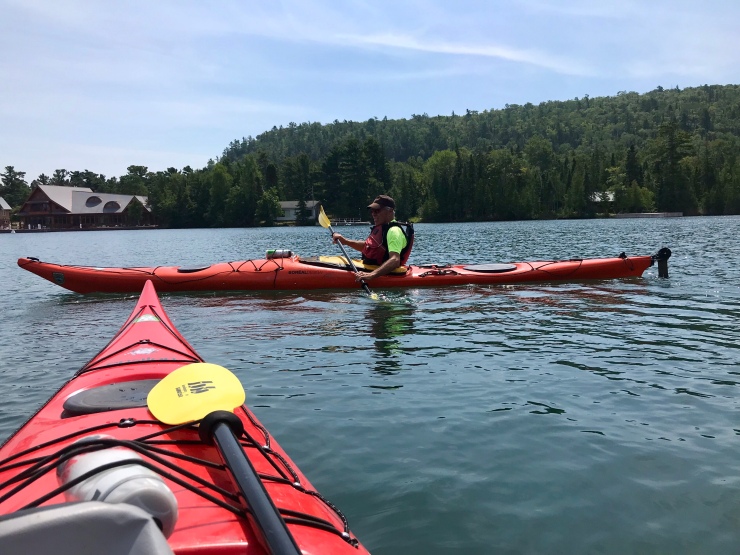
We spent the better part of an afternoon on the water. Matt the Guide was great – informative, enthusiastic, patient.
We started in the calm waters of Copper Harbor, where we practiced the special hip action that kayak rocking requires to stay upright amid the swells and pitches. Then we ventured out beyond Porter’s Island into muscular Lake Superior, the largest freshwater lake in the world.
I was a Nervous Nellie about the possibility of dropping my iPhone in the water, so my photos are few and far between.

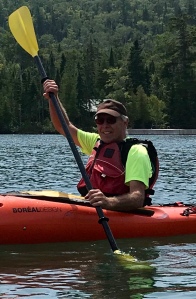
There’s a special serenity in being so low and slicing silently through large rolls of water. The scenery was gorgeous, the experience exhilarating. I can’t wait to do it again.
CYCLING
Michigan’s bike paths are the best. Most are built on abandoned rail beds and are either paved or hard-surfaced with compacted crushed stone. They are usually separate from roads – meaning you share them only with hikers and fellow cyclists – so you don’t have to endure the noise or fumes of passing cars and trucks.
They are well labeled and feature water stations and bike racks – even special bike toolkits – along the way. And in a nice touch, most state parks in Michigan are free to hikers and cyclists.
Our first bike ride was along Lake Huron’s lovely Saginaw Bay near Bay City (where the “thumb” juts out from the “mitten”). We managed to get back to our Casita in Bay City just before it rained.

Later, we biked Mackinac Island, where cars have been banned since 1898. What a wonderful interlude this was. Here’s a short video of the scenery from my bike.
You leave the rest of the world behind as you board the 20-minute ferry to the island. Away from the bustle of the ferry dock, the island is clean and peaceful, so quiet you can hear the wind.
The water is crystal clear.
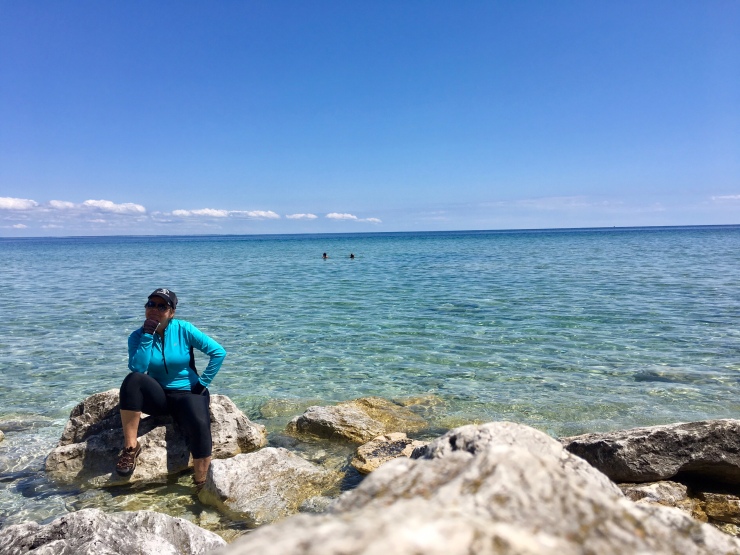
We spent the whole day on our bikes, enjoying the views from the heights of the island’s center and pedaling on miles of paved bike paths along the Lake Huron shore. Here’s a view from Arch Rock near the top.

Here’s my first – and probably only – video-selfie on my bike along the shoreline. (Kids: Don’t try this at home.)
We marveled at the perfectly round and smooth pebbles that form the beaches. As the waves lap gently at your feet, you can actually hear the pebbles tinkle back into the water as each wave recedes.

A few facts of interest:
- This area was fur central in the 18th and 19th centuries. Fishing became a major industry, then the focus was Victorian-era tourism, which is when Mackinaw became famous for its fudge. (With good reason; G and I sampled the wares.
- There are 500 full-time residents on the island and they elect their own mayor and council. Thousands of tourists visit in the summer.
- There is a Governor’s Summer House, which some governors use more than others. (The current one not so much.) Here’s a picture of the view from just outside the Governor’s summer house.
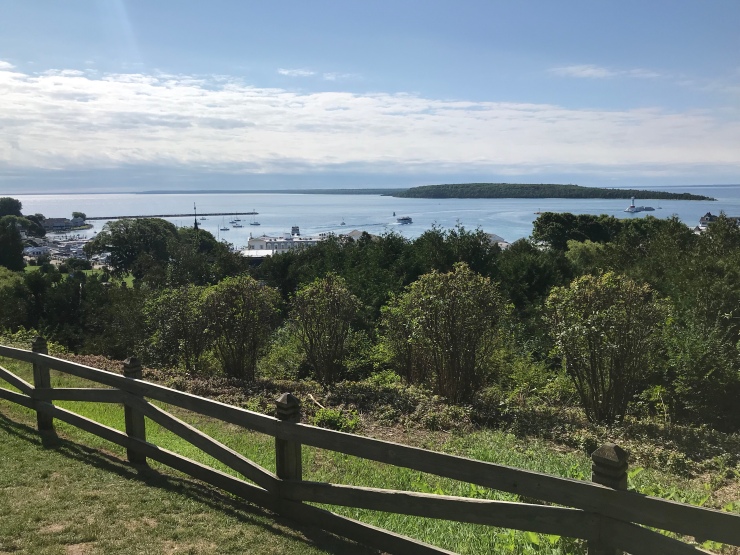
We pedaled past the famous Fort Mackinac.
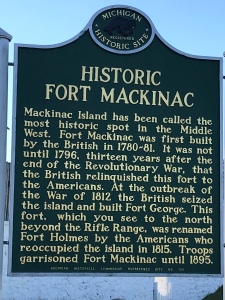
The Grand Hotel is indeed grand, reminds me of the Hotel del Coronado in San Diego.
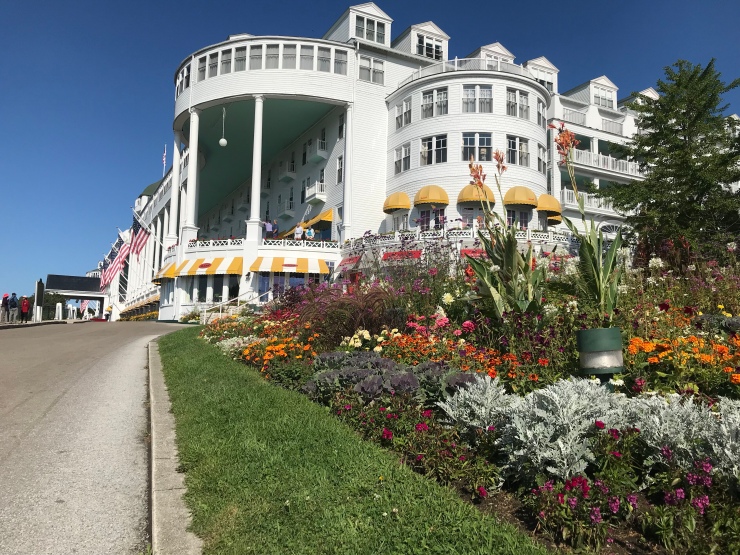
Mackinac, by the way, translates roughly as Great Turtle, which is generally the shape of the island. You don’t pronounce the “c” – whether you’re referring to the city or the island.
There are lots of horse carriages. For tourists they are a novelty. For residents and workers, they are a way of life, providing the only way to deliver goods and equipment to homes and businesses.
It’s a family place, with lots of parents on bicycles pulling baby trailers. A couple of those baby trailers actually had dogs in them – with their own doggie seat belts, of course.
As you can see, it was a lovely August day.

We also enjoyed some liquid libation.

The next day we biked further southwest – along the shore of Lake Michigan, from Harbor Springs through Petoskey State Park, out Bear Creek and over to East Park.
We learned from a marker along the way that Bear Creek runs out of natural body of water called “Walloon Lake.” We didn’t see reference to any Walloon-Belgian influence in the area, but G – from Wallonia – was tickled by the lake’s name nonetheless.
Still later, on Lake Superior, we picnicked and biked on Presque Isle and around Marquette, home to the University of Northern Michigan (not Marquette University, which is in Milwaukee). G walked to the end of this jetty to inspect the historic lighthouse.

On this pedal jaunt we learn:
- Lake Superior is so cold that few organisms can live in it. That’s why it’s so clear.
- The water has one exit point – the St. Mary’s River at the east end of the lake where it enters the Soo Locks en route to Lake Huron. (See detail re Soo Locks in the Museum section below.)
- It takes 190 years for a single drop of water to travel through Lake Superior before exiting on its journey to the other Great Lakes.
- This lake contains 10 percent of the world’s freshwater. It holds three quadrillion gallons of water – enough to cover North and South America with a foot of water.
- The 1,826-mile lake-perimeter shoreline is about the same as the coast of the United States from the tip of Maine to southern Georgia.
- The average temperature of the water in Lake Superior is 40 degrees. (We actually saw people swimming in it!)
Even with all this biking, we didn’t begin to scratch the surface of Michigan’s cycling trails….
SCENERY
It’s hard to know where to start in describing the beauty of Michigan’s scenery. The forests, for example, are denser than I imagined. They remind me of Pulitzer Prize winner Annie Proloux’s latest book, Barkskins, set in the deep forests of the Northeast, which I read shortly before our departure from Dallas last March.
The captivating novel, which traces the descendants of two immigrants to “New France” over the course of three centuries in the timber industry, is set mostly in upper New England but expands in later chapters into the woods of Michigan.
Now I understand why.
And the state’s geology is fascinating, especially to a rock buff like G. He spent nearly an hour at a highway rest stop near Detroit that had an excellent large rock display, complete with full explanatory plaques. Here’s just one example.

One day we visited the Tahquamenon Falls (rhymes with “phenomenon” and means “short cut”) This is the Tahquamenon River as it flows around an eight-acre island and forms the “lower falls.”

We walked on in to the upper falls, which reportedly are among the largest falls east of the Mississippi River – after Niagara. Here’s a short video of the 50-foot tall, 200-foot long falls, with a flow of some 50,000 gallons per second.
The tan coloration is the result of tannic acid, a natural substance found in decomposing vegetation. Its variegated reflection in the falling water reminds me of strands of carefully highlighted hair.
This prayer along the walk out to the falls is captivating.
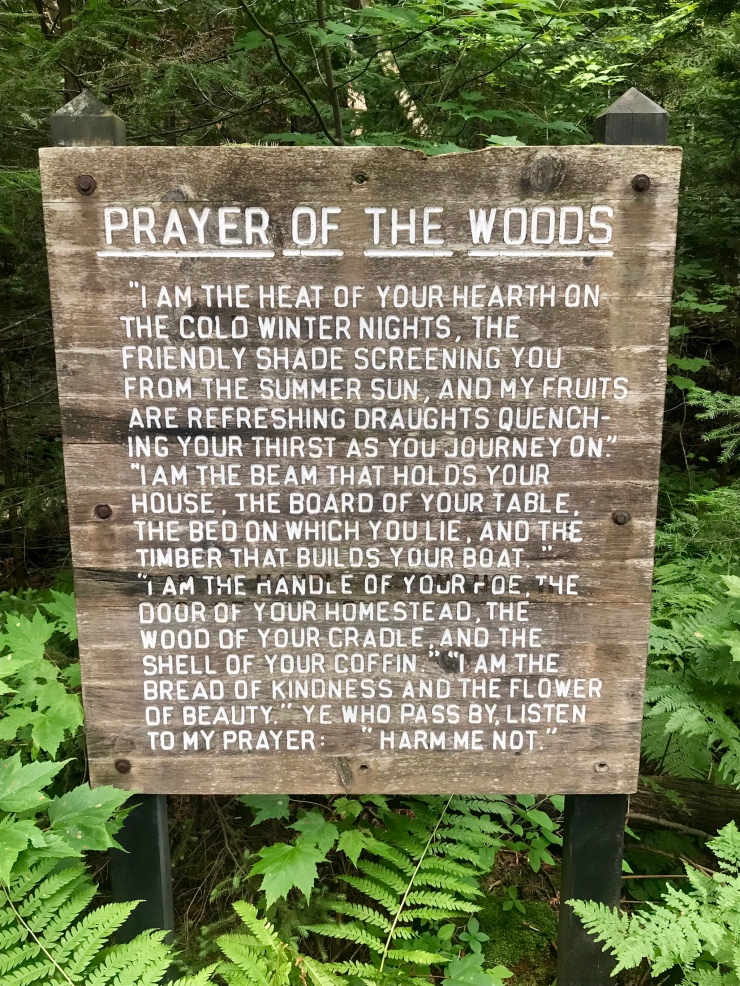
From there, we visited Grand Marais and Munising along the shore of Lake Superior. The Pictured Rocks National Lakeshore is beautifully scenic – both from land looking down and from the lake looking up.
We weren’t the only visitors early one morning.
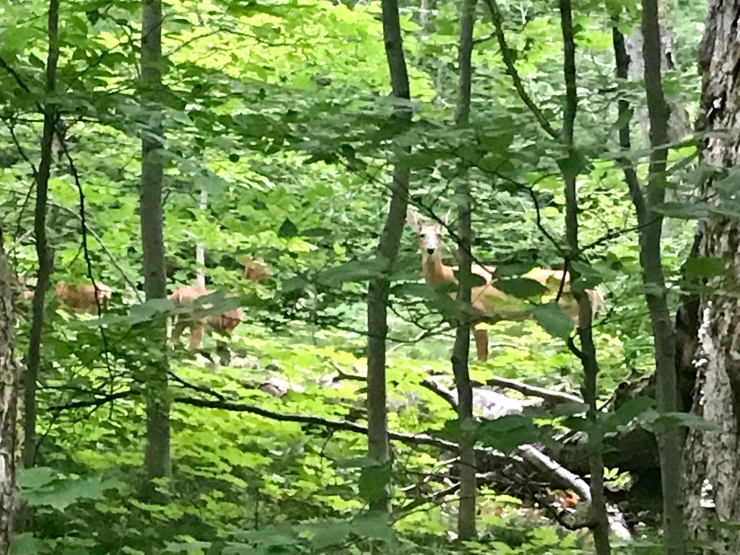
It’s hard to believe Lake Superior isn’t an ocean. Here’s the view from Log Slide Overlook.

And a view of Miner’s Rock from above.

Later, we took a boat to see the “pictured rocks” at eye level.

According to Capt. Balko, Lake Superior is nearly 350 miles long. It’s 160 miles across to Canada. It has a 32,000-square mile surface. Some 200 rivers feed into it. It is 1,300 feet deep at its deepest.

The scenery was awe inspiring. Some of the cliffs top 250 feet. (Note tiny person on top.)
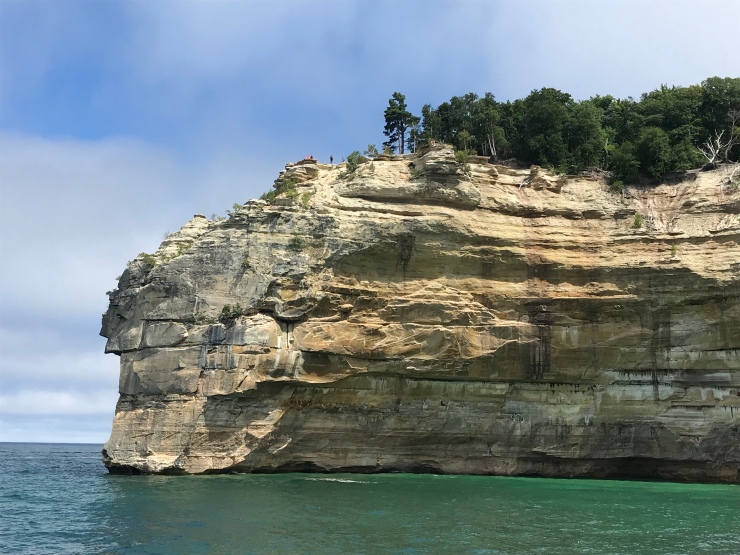
We got up close to several of them

And then we got closer….
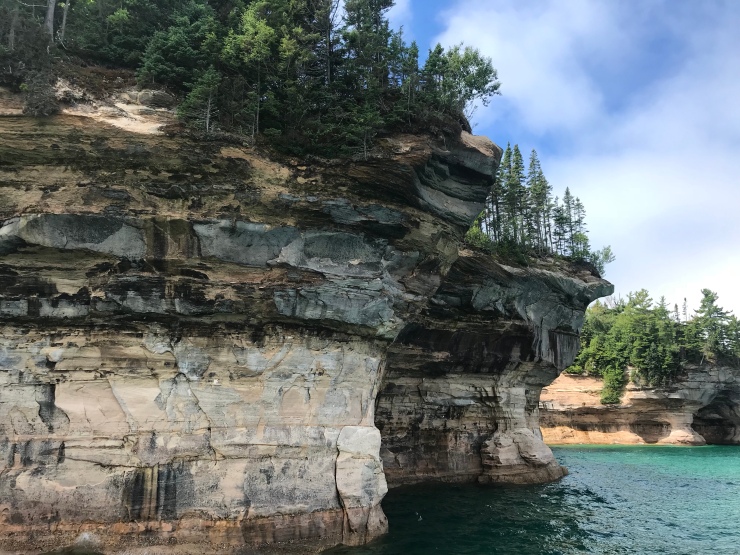
And then we got closer still….
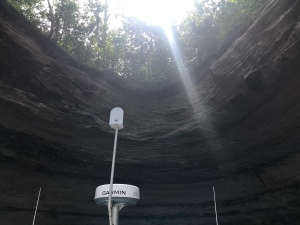
The East Channel Lighthouse on the way back to the ferry dock was lovely.

The shades of ochre, tan, brown, white, green are the result of minerals and metals in the stone. The gray stone on top is dolomite, the red pre-Cambrian sandstone. The water is turquoise-to-cobalt blue. The deep forest emerald, black, gold, rust.
It’s a rich palette of painter’s colors.
The colorations made me think of paint dripping down the side of a rusty can.
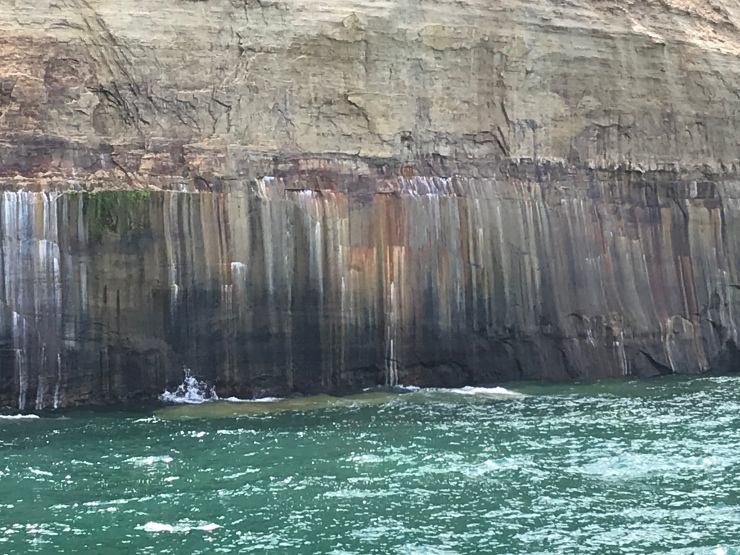
I imagined other designs dancing on the walls: I see Victorian ladies in big hats serving tea to one another. I see a cougar posing for a photo, Rip Van Winkle’s profile, a shark head, elephant feet and a Rockettes’ line doing high kicks. Puff the Magic Dragon. Hoodoos like those in Utah’s Bryce Canyon….
Capt. Balko jolts us back to reality. Tourism and paper are the main industries here. This area gets 200-250 feet snow each winter. The Munising Bay freezes over three feet deep. You’ll find 30-40 ice shacks here then.
Yeegads. No thank you.
Eventually, we headed toward the Keweenaw Peninsula, the far northwestern tip of the Upper Peninsula. We stopped at Canyon Falls on the Sturgeon River. The tannic-colored water in this short video makes me think of root beer.
The area of Allouez nearby got a record 390.4 inches of snowfall during the winter of 1978-79. I couldn’t imagine what that amount of snow looks like.
Now I can.
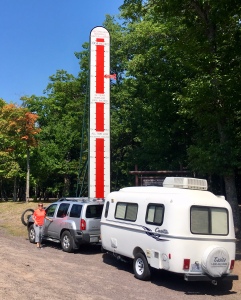
Later, we stopped at Great Sand Bay, where I dipped my toes into Lake Superior and G (the green-shirted dot at bottom of stairs) collected a half dozen lovely stones.
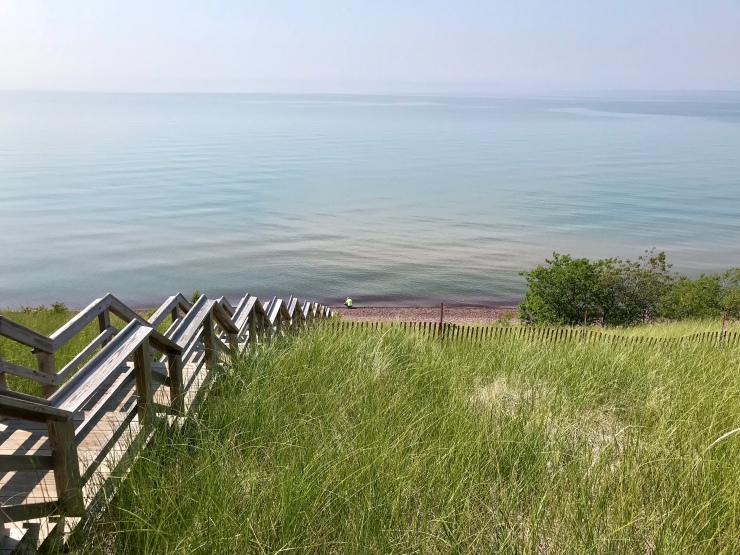
A sign nearby said that freighters passing this point of Lake Superior carry more tonnage each season than the combined tonnage of the Panama, Kiel and Suez canals. (More on this point in the section on Soo Locks below.)
And I loved Point Isabelle on the south side of the peninsula, named for my granddaughter, I’m sure.

MUSEUMS
We visited three – one regarding an industrialist, one about an industry and another about the tragedy of shipwrecks. Each was outstanding.
So impressed were we by the Henry Ford Museum of American Innovation in Dearborn – where we spent the entire day and saw probably half of the exhibits – that we were two-thirds of the way up the “mitten” the next day before we realized that we’d forgotten to go to the Gerald R. Ford Presidential Museum in Grand Rapids.
We’re presidential museum geeks, having been to seven of the 13, so this was a serious oversight. As chief navigator of our Year on the Edges of America, I was especially dismayed – until G pointed out that our failure to experience the “other” Ford museum this time just provides another reason to visit Michigan again, perhaps as soon as next summer.
That worked.
1.The Henry Ford museum – first recommended to us by friend Marc in Quebec last month – is exceptionally informative, exquisitely well organized and affordably priced.
Most impressive was “The Rouge” factory tour, named for the river nearby. It’s a short bus ride from the museum to the actual F-150 truck factory, which features a nearly mile-long skywalk loop that allows you to peer down on the 1,500 assembly-line workers below.
The men and women of all ages and color work at a leisurely but unrelenting methodical pace. It’s not as noisy as I expected, but many of the workers wear headphones and seem to be rocking out to their own music. We watched doors being assembled, windshields being installed, cabs being built. Everything on the line is as perfectly synchronized as a ballet.
(Sadly, no photography allowed.)
Also impressive is the factory’s roof. It’s green – literally – planted with 454,000-square feet of groundcover. The roof – nearly 100-times bigger than a regulation basketball court – helps with temperature control, insulation and air quality – reportedly saving the company millions of dollars in energy costs.
From there we returned to the museum. It’s a good thing they close at 5 p.m. or we’d likely still be there, poking our noses into this nook or that cranny, learning more about the history of the automobile, Henry Ford’s eccentric genius and how the development of motorized transportation shaped the world. A few highlights:
- Ford revolutionized the assembly-line way of working, by bringing the work to the worker, rather than the worker to the work. In the beginning it took, 12 hours to assemble a Model T; today an F-150 truck comes off the line every minute.
- Thomas Edison and Charles Lindbergh were friends. So close was he to the inventor of the lightbulb that Edison’s son gave Ford a capsule of his father’s “last breath” upon his father’s death. The capsule is on display.
- Ford had tremendous influence on the travel industry, including the development of RVs. The museum includes an early camper that he made and gave to the Lindbergh family. Of special interest to us was the actual van that Charles Kuralt used for 27 years of “On the Road” dispatches from around America.

Ford also influenced the aviation industry and I appreciated the museum’s emphasis on women aviators, from the famous (e.g. Amelia Earhart) to little-known (e.g. stunt fliers like Katherine Stinson).
Ford made headlines when he doubled daily wages to $5 during the 1930s. He wanted his employees to be able to afford the cars they were building. He also needed to retain employees at what was largely boring, rote work. Wanna-be workers flooded Detroit.
The museum treats the UAW respectfully. One of the videos acknowledges Ford’s opposition to union demands at the time, but recognizes that the company’s “partnership” with the union helped revolutionize the industry.
Two little-known bits of Ford-related correspondence are on display:
- John Dillinger’s 1934 letter to Henry Ford complimenting his creation and suggesting a brand motto: “Have a Ford and watch the other cars fall behind you.”
- Clyde Barrow (of Bonnie and Clyde fame) wrote Ford to compliment his Ford getaway car as a “dandy.”
I wish we’d had our grandkids Isa and Alex with us. They would have loved the museum and the neighboring Greenfield Village of outdoor historic districts populated by period-appropriate residents.
My only criticism of the museum metropolis, and it’s faint, is the sprawling unfocused nature of it all. It makes sense to have the limo JFK was riding in when he was assassinated there, for example, because it’s historic and it’s a Ford Lincoln. But there are collections of guitars, Holiday Inn and McDonald’s early paraphernalia, race cars, airplanes, a replica of the bus Rosa Parks refused to give her seat up on, and much, much more.
What’s the connective tissue, beyond the theme of “innovation?” I’m not sure.
And not surprisingly, the museum goes light on Ford’s eccentricities. One of the books I enjoyed early in my nine-year tenure on the Pulitzer Prize Board was Fordlandia by Greg Grandin. A finalist for the 2010 Prize for history, the book recounts Ford’s failed effort to build a community based on “American values” in the jungle of Brazil to produce rubber for his cars and other industry. Ford came across as brilliant but also astonishingly arrogant and even racist – a very flawed genius.
Here’s an excerpt from the 2010 New York Times review of the book:
Ford was obsessed, among other things, by Thomas Edison, soybeans, antiques and order. He hated unions, cows, Wall Street, Franklin Roosevelt and Jews. He also, fatally, despised experts. Ford’s Amazon team had plenty of able men, but as Grandin observes, “what it didn’t have was a horticulturalist, agronomist, botanist, microbiologist, entomologist or any other person who might know something about jungle rubber and its enemies” — the lace bugs and leaf blight that laid siege to the rubber trees, the swarms of caterpillars that left areas of the plantation “as bare as bean poles.”
Still, this ranks as one of the best museums we’ve been experienced.
2.The Thunder Bay National Marine Sanctuary and Underwater Preserve is a 4,000 square mile park off the cost of Alpena (on the east side of the upper part of the mitten) dedicated to the preservation of 116 historically significant shipwrecks.
This engaging museum commemorates the Shipwreck Century of 1825-1925. That’s when the push for speed on the Great Lakes caused more wrecks than ever before. There were more than 200 shipwrecks in the Thunder Bay region alone – 99 wrecks have been found so far.
Here’s just one shelf of the thousands of artifacts that have been discovered, cleaned and labeled by divers and scientists.
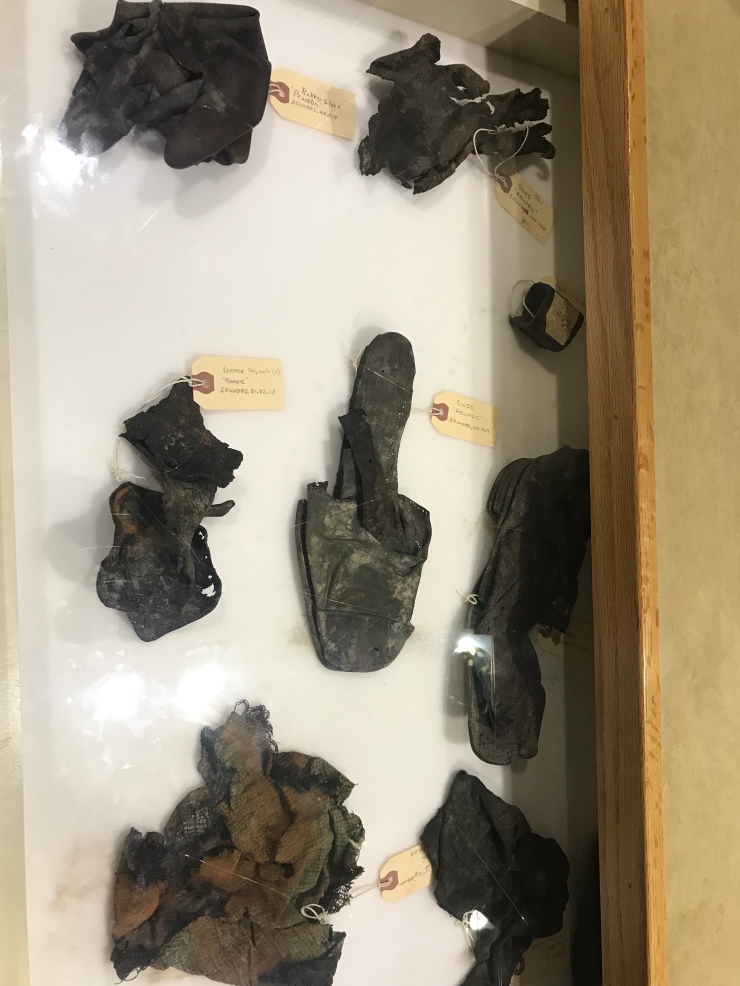
There are three generally accepted causes for the high concentration of wrecks in this area. First, this is the center of traffic across the Great Lakes – all boats from Lake Superior and Lake Michigan must go through Lake Huron to get to the Atlantic. Second, there are lots of dangerous shoals in the area. Third, the weather is changeable, fierce and unpredictable. (It’s called Thunder Bay for a reason.)
We’d hoped to take a glass-bottom boat tour of several of the wrecks, but it was cancelled the day we were there due to weather. Just as well – we’d hate to become Shipwreck 201.
3.The Soo Locks in Sault St. Marie are among the busiest in the world, connecting the massive Lake Superior to the shallower Lake Huron. Some 80 million tons of cargo go through these every year. Most valuable cargo: iron ore and coal.
The locks are what connects the Atlantic Ocean to Duluth, Minnesota, which is – believe it or not – the westernmost Atlantic seaport, some 2,342 miles from the sea.

The visitor’s center is excellent; so is the tiered elevated platform from which you can observe the locks in operation. We watched the huge Lee A. Tregurtha cargo boat move through one lock from Lake Superior to Lake Huron, a 21-foot drop, and the smaller Nokomis tour boat move the other direction across another lock.
Here’s the cargo boat exiting the locks after having been “lowered” into Lake Huron from Lake Superior.
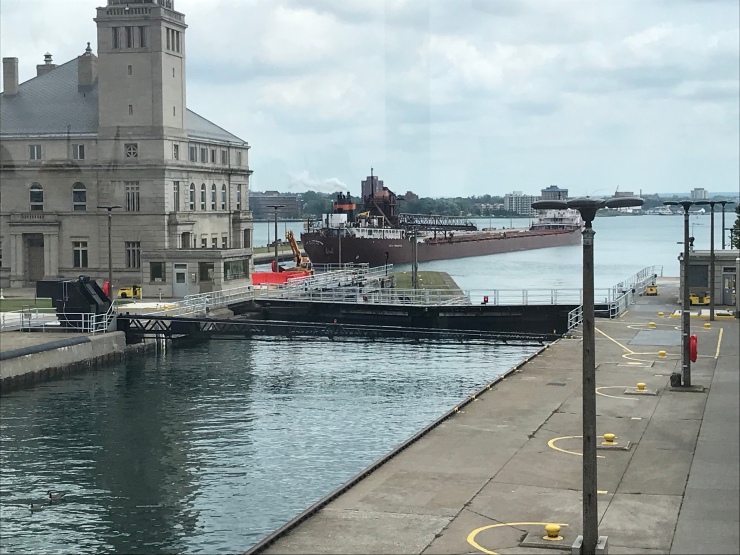
And here’s the tourist boat being “lifted” in the lock from Lake Huron to Lake Superior.

A few interesting facts:
- These locks can accommodate a 1,000-foot boat. How big is a 1,000-foot boat? Nearly three football fields, or 4/5 of the total height of the Empire State building. In a single trek, this boat can carry the equivalent of 3,000 25-ton trucks or 700 train cars.
- It takes 22 million gallons of water to lift a boat through the Poe lock.
- Crews complete more than 7,000 lockages during the 42-week long navigational season.
- The first lock on St. Mary’s River was built in 1798 and it was a canoe lock, 40 feet long 9 feet wide. American forces destroyed it during the war of 1812 and for the next 40+ years cargo had to be carried around the Rapids.
- The locks still operate using their original engineering, masterminded by a man with a third-grade education.
PEOPLE
Michigan is the Florida of the North, in terms of access to waterways. But more people in Michigan are from Michigan than Florida residents are from Florida. We met many wonderful Michiganders during our two-week traverse, all of them intensely proud of their state and its natural resources.
G met Rick one afternoon at a laundromat in Detroit, for example. (I was at the airport with Mom, prepping for her flight home to Dallas after our week with family in Ohio.) Short, probably in his 60s with a non-stop smile, Rick was intrigued by our Casita and quick to recommend places we should be sure to see during our tour of his native state. He warned us to keep a close eye on our fuel gauge as gas stations on the Upper Peninsula are few and far between.
He also suggested we move to a different shopping center to overnight in a better neighborhood – which we did. We discovered 24-hour Meijer supermarkets – a high-end version of Walmart – in the process. And the one in Allen Park is outstanding.
The next evening, we returned to the parking lot after a full day at The Henry Ford and who should pull up next to us? Rick! He decided to check on us to be sure we were safe, and he had some questions for us about the Casita. (He’d already googled the Texas-based company and ordered a brochure.) We gave him a tour of our abode, answered a few questions and then bid one another bon voyage.
Then there was Tom. We met him the next morning in the same parking lot. He drove up in his Dodge minivan and asked how we liked our Casita trailer. We chatted, showed him the inside. He told us about air shocks for cars, which really intrigued G.
When he learned of our plan to spend some time along the perimeter in Michigan, he was full of suggestions. He recommended the sand dunes in the upper part of lower Michigan and the Pictured Rocks National Lakeshore; he warned us to beware of the rip tides in Lake Superior. They can kill.
We’ve stayed in touch with both Rick and Tom.
Later, we met Barb and Pete on the Upper Peninsula. They’re both from lower Michigan. We met them at dusk one evening as we walked along Shelldrake Dam in the state forest at Andrus Lake near the northeastern tip of the UP. The next morning we ran into them again, at their campsite. We traded book and site-seeing recommendations, and we snapped this selfie.

And we appreciated Doug and Pat, also from lower Michigan, who were enjoying the Pictured Rocks boat tour with 11-year-old grandson, Sam. Sadly, we didn’t think to get a photo of them but we’ll remember them nonetheless: They left a kind note on our windshield the next day in another city some 45 miles away!
Best of all were our neighbors down the way at the Fort Wilkins State Park campground in Copper Harbor, on the northwestern-most tip of the UP. Dave and friends had taken his 17-foot boat 40 miles out into Lake Superior the previous day and caught 10 lake trout.
That’s a lot of fish.
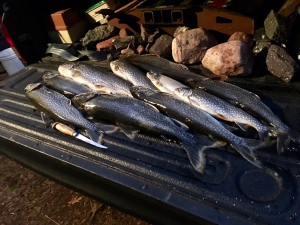
And they smelled great on the grill. G, on his way to the “comfort station” at the state park one evening, complimented Dave on what looked like a feast fit for kings. Before we knew it, grill master Dave and friends invited us to join their trout dinner around the campfire.
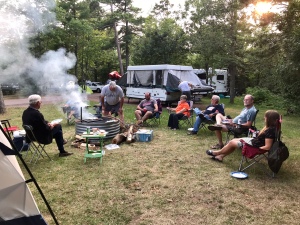
Turns out this group of eight from across the Midwest meets every year at this time at this very campsite. They are:
- Dave and Judy of Cadillac, Michigan. (I think she actually caught the largest fish of the day!)
- Marzena Mickiewicz of Poland and her financial-planner son, David, of Bridgeview, Illinois.
- Tom and Lucy of Fenwick, Michigan (the photos of the trout above and below are courtesy of Tom).
- Mark and Jolanta of outside of Chicago. (She’s Marzena’s sister and also a native of Poland; he talked rocks with G.)

Here’s Tom with one of the just-caught fish from the day before.
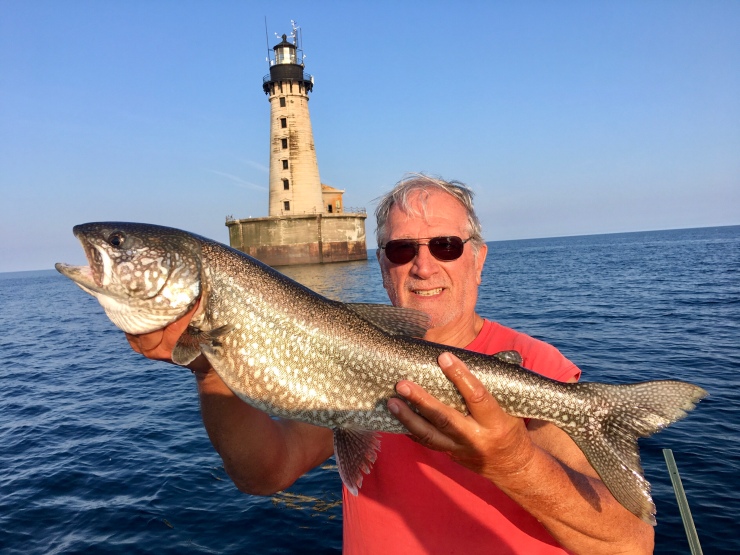
It was a wonderful evening, typical of what makes this sort of outdoor, engaged living so rich. We traded origin stories; talked about rocks, mountains and fish. We laughed and we teased.
Who knows, maybe we’ll find ourselves at Fort Wilkins State Park about this time next year….
I know one thing for sure: Michigan has won our hearts. We will return.
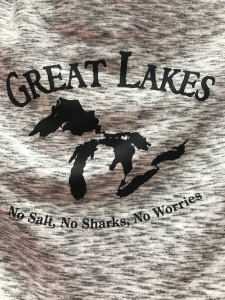

Keven, loved the big smile on your face in the “selfie video” on your bike; there’s something joyous about being on a bicycle that just turns you into a kid again.
LikeLiked by 1 person
Yes, that’s so true!
LikeLike
Such a wonderful recap of your Michigan adventures! You could work for the “Pure Michigan” campaign! Thanks for remembering us & our brief encounter in the Paradise area. I will follow you and do some catching up on the previous posts. Take care!
Barb (&Pete)
(BTW, my cousin Steve is now in KY!)
LikeLiked by 2 people
So glad to have met you and that you read the blog. Let’s stay in touch!
LikeLiked by 1 person
Loved this post, your discussion of Lake Superior was fascinating! My sister lives in lower Michigan, so I’m familiar with some of its charms. The northern reaches of the state remain on our bucket list for when we can spend more time. Thanks for recommendation on reading your camping comforts post, it was very helpful!
LikeLike
Glad it was helpful and that you enjoyed the posts. More to come!
LikeLike
I love all of it! So happy that you have been able to explore our beautiful country!
LikeLiked by 1 person
Thanks, Mary. Nobody should be allowed to have this much fun!
LikeLike
We loved reading your description of the UP. Despite being born in Michigan, we didn’t discover the Grand Marais/Munising area until a few years ago when we moved from Dallas and retired to northern Michigan. I think I’d eat breakfast at the diner in Grand Marais every morning if it weren’t such a drive. When you return to Michigan, I hope that you can explore the west coast of Michgan, as well! https://www.travelmag.com/articles/the-pierce-stocking-scenic-drive/
LikeLiked by 1 person
Thanks, Linda. Yes, we only got as far down as Little Traverse Bay on the west side of lower Michigan. We missed the sand dunes, etc. Next time!
LikeLike
We love the Upper Peninsula. The Landmark in Marquette is a fine hotel. The airport is a former SAC base, so any plane can land there. The only original hardwood forest in Michigan is just west of Marquette, preserved by Henry Ford. Glad you made it to Copper Harbor, almost no one sees that spot. On the way there you can see the George Gipp monument (“win one for the Gipper”). We also like Ashland, WI and up the Superior coast from Duluth to Thunder Bay, Ont. Hope you get over to Ely and pass through the Boundary Waters. Spectacular canoeing and scenery. Not sure if you read Jim Harrison, but since you liked Michigan, he captures its wilderness very well.
LikeLiked by 1 person
Thanks, Bob. So great to hear from you. I thought of you and Diane several times during our two weeks in the Great Lakes State, knowing how much you two love it here. Loved the Marquette area, Copper Harbor and Ashland. We’ll have to do Thunder Bay in Ontario, Ely and Boundary Waters next time around. Thanks for the Harrison recommendation!
LikeLike
What a terrific post! It’s never occurred to me to want to vacation in Michigan, but now it’s on my list.
And, totally off the subject, did you get a haircut?
LikeLiked by 1 person
Ha! Highly recommend Michigan. Whacked my hair very short in Feb I. Dallas, again in Philly in June. Trying to stick it out now to Seattle in September -a bit of a reach…. 🤦♀️
LikeLike
Keven, this was your very very very best post so far!! So full of beautiful photos and videos and all kinds of amazing facts. Thank you so much for taking the time to post this for your grateful viewers. I will watch this again.
Elayne V
LikeLiked by 1 person
Thank you, Elayne!
LikeLike
I’m aching with envy but if I ever make it to Michigan I’m taking this piece of yours as my guide. Thanks for alerting me to Proulx’s new novel. Her “Shipping News” is one of my all time favorite reads and I’m looking forward to enjoying this one.
LikeLiked by 1 person
Thank you, Bill. It’s always so wonderful to hear from you. I think you and Fran would especially enjoy Pictured Rocks Natl Lakeshore.
LikeLike
Diane and I almost bought a summer house on the edge of Pictured Rocks. Can’t recall why the deal collapsed. Did you notice the ‘Lil Abner themed restaurant in town.
LikeLiked by 1 person
Now THAT would have been a summer house of dreams! We missed ol ‘Lil Abner…. Darn.
LikeLike
So glad you got to experience Michigan. It’s one of our favorite states! Has everything (even good wineries) and is so beautiful too. We spend lots of time there.
LikeLiked by 1 person
Thanks, Ann. Great to hear from you. Yes, a wonderful state indeed!
LikeLike
Looks like you had a fabulous time
in Michigan. I enjoyed a visit to the locks when we were in Canada near Niagara Falls. I think a trip to visit all of the Great Lakes should now be added to my list after your post.
You are going to need a whole new address book with all of your new found friends. Looking forward to the next chapter.
LikeLiked by 1 person
Thanks, Deb. That’s a problem (needing a new address book) I’m happy to have!
LikeLike
Great post and photos. Pictured Rocks is one of my favorite places. Were the black flies or mosquitoes bad?
LikeLiked by 1 person
They really weren’t that bad, thank goodness! In two weeks, I probably acquired a half dozen mosquito bites and no black fly bites. Amazing!
LikeLike
Loved that whole area when we did our Great Lakes road trip. When I think of it, the word that comes to mind is lush. The water is so clear it goes from pastel to intense. So enjoying seeing some of the places we’ve been again.
LikeLiked by 1 person
So agree. Thanks for the comment!
LikeLike